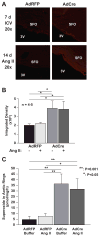Induction of hypertension and peripheral inflammation by reduction of extracellular superoxide dismutase in the central nervous system
- PMID: 20008675
- PMCID: PMC2813894
- DOI: 10.1161/HYPERTENSIONAHA.109.142646
Induction of hypertension and peripheral inflammation by reduction of extracellular superoxide dismutase in the central nervous system
Abstract
The circumventricular organs (CVOs) lack a well-formed blood-brain barrier and produce superoxide in response to angiotensin II and other hypertensive stimuli. This increase in central superoxide has been implicated in the regulation of blood pressure. The extracellular superoxide dismutase (SOD3) is highly expressed in cells associated with CVOs and particularly with tanycytes lining this region. To understand the role of SOD3 in the CVOs in blood pressure regulation, we performed intracerebroventricular injection an adenovirus encoding Cre-recombinase (5x10(8) particles per milliliter) in mice with loxP sites flanking the SOD3 coding region (SOD3(loxp/loxp) mice). An adenovirus encoding red-fluorescent protein was injected as a control. Deletion of CVO SOD3 increased baseline blood pressure modestly and markedly augmented the hypertensive response to low-dose angiotensin II (140 ng/kg per day), whereas intracerebroventricular injection of adenovirus encoding red-fluorescent protein had minimal effects on these parameters. Adenovirus encoding Cre-recombinase-treated mice exhibited increased sympathetic modulation of heart rate and blood pressure variability, increased vascular superoxide production, and T-cell activation as characterized by increased circulating CD69(+)/CD3(+) cells. Deletion of CVO SOD3 also markedly increased vascular T-cell and leukocyte infiltration caused by angiotensin II. We conclude that SOD3 in the CVO plays a critical role in the regulation of blood pressure, and its loss promotes T-cell activation and vascular inflammation, in part by modulating sympathetic outflow. These findings provide insight into how central signals produce vascular inflammation in response to hypertensive stimuli, such as angiotensin II.
Figures




Comment in
-
Angiotensin II, oxidant signaling, and hypertension: down to a T?Hypertension. 2010 Feb;55(2):228-30. doi: 10.1161/HYPERTENSIONAHA.109.144477. Epub 2009 Dec 14. Hypertension. 2010. PMID: 20008674 Free PMC article. No abstract available.
Similar articles
-
Role of vascular extracellular superoxide dismutase in hypertension.Hypertension. 2011 Aug;58(2):232-9. doi: 10.1161/HYPERTENSIONAHA.111.172718. Epub 2011 Jul 5. Hypertension. 2011. PMID: 21730294 Free PMC article.
-
Role of the NADPH oxidases in the subfornical organ in angiotensin II-induced hypertension.Hypertension. 2013 Feb;61(2):382-7. doi: 10.1161/HYPERTENSIONAHA.111.00546. Epub 2012 Dec 17. Hypertension. 2013. PMID: 23248154 Free PMC article.
-
Role of Menkes ATPase in angiotensin II-induced hypertension: a key modulator for extracellular superoxide dismutase function.Hypertension. 2008 Nov;52(5):945-51. doi: 10.1161/HYPERTENSIONAHA.108.116467. Epub 2008 Sep 2. Hypertension. 2008. PMID: 18768397 Free PMC article.
-
Oxidative stress and hypertension.Med Clin North Am. 2009 May;93(3):621-35. doi: 10.1016/j.mcna.2009.02.015. Med Clin North Am. 2009. PMID: 19427495 Review.
-
Role of superoxide dismutase 3 in skin inflammation.J Dermatol Sci. 2012 Aug;67(2):81-7. doi: 10.1016/j.jdermsci.2012.06.003. Epub 2012 Jun 16. J Dermatol Sci. 2012. PMID: 22763488 Review.
Cited by
-
Recent advances in central cardiovascular control: sex, ROS, gas and inflammation.F1000Res. 2016 Mar 31;5:F1000 Faculty Rev-420. doi: 10.12688/f1000research.7987.1. eCollection 2016. F1000Res. 2016. PMID: 27092251 Free PMC article. Review.
-
Angiotensin II-induced production of mitochondrial reactive oxygen species: potential mechanisms and relevance for cardiovascular disease.Antioxid Redox Signal. 2013 Oct 1;19(10):1085-94. doi: 10.1089/ars.2012.4604. Epub 2012 May 21. Antioxid Redox Signal. 2013. PMID: 22443458 Free PMC article. Review.
-
Vascular inflammation and endothelial dysfunction in experimental hypertension.Int J Hypertens. 2011;2011:281240. doi: 10.4061/2011/281240. Epub 2011 Sep 11. Int J Hypertens. 2011. PMID: 21915370 Free PMC article.
-
Inflammation and neurogenic hypertension: a new role for the circumventricular organs?Circ Res. 2010 Jul 23;107(2):166-7. doi: 10.1161/CIRCRESAHA.110.224873. Circ Res. 2010. PMID: 20651292 Free PMC article. No abstract available.
-
ADAM17-Mediated Shedding of Inflammatory Cytokines in Hypertension.Front Pharmacol. 2020 Jul 29;11:1154. doi: 10.3389/fphar.2020.01154. eCollection 2020. Front Pharmacol. 2020. PMID: 32848763 Free PMC article. Review.
References
-
- Beyer W, Imlay J, Fridovich I. Superoxide dismutases. Progress in nucleic acid research and molecular biology. 1991;40:221–253. - PubMed
-
- Fukui T, Ishizaka N, Rajagopalan S, Laursen JB, Capers Qt, Taylor WR, Harrison DG, de Leon H, Wilcox JN, Griendling KK. p22phox mRNA expression and NADPH oxidase activity are increased in aortas from hypertensive rats. Circ Res. 1997;80:45–51. - PubMed
-
- Schnackenberg CG, Welch WJ, Wilcox CS. Normalization of blood pressure and renal vascular resistance in SHR with a membrane-permeable superoxide dismutase mimetic: role of nitric oxide. Hypertension. 1998;32:59–64. - PubMed
-
- Jung O, Marklund SL, Geiger H, Pedrazzini T, Busse R, Brandes RP. Extracellular superoxide dismutase is a major determinant of nitric oxide bioavailability: in vivo and ex vivo evidence from ecSOD-deficient mice. Circ Res. 2003;93:622–629. - PubMed
Publication types
MeSH terms
Substances
Grants and funding
LinkOut - more resources
Full Text Sources
Other Literature Sources
Medical
Miscellaneous

